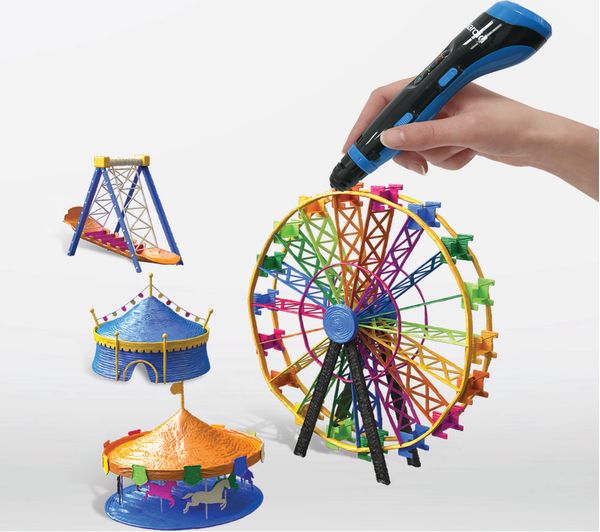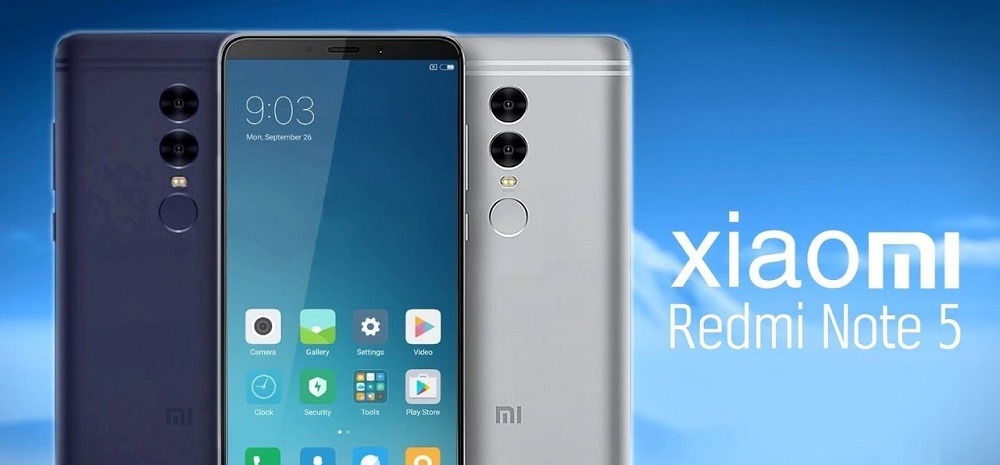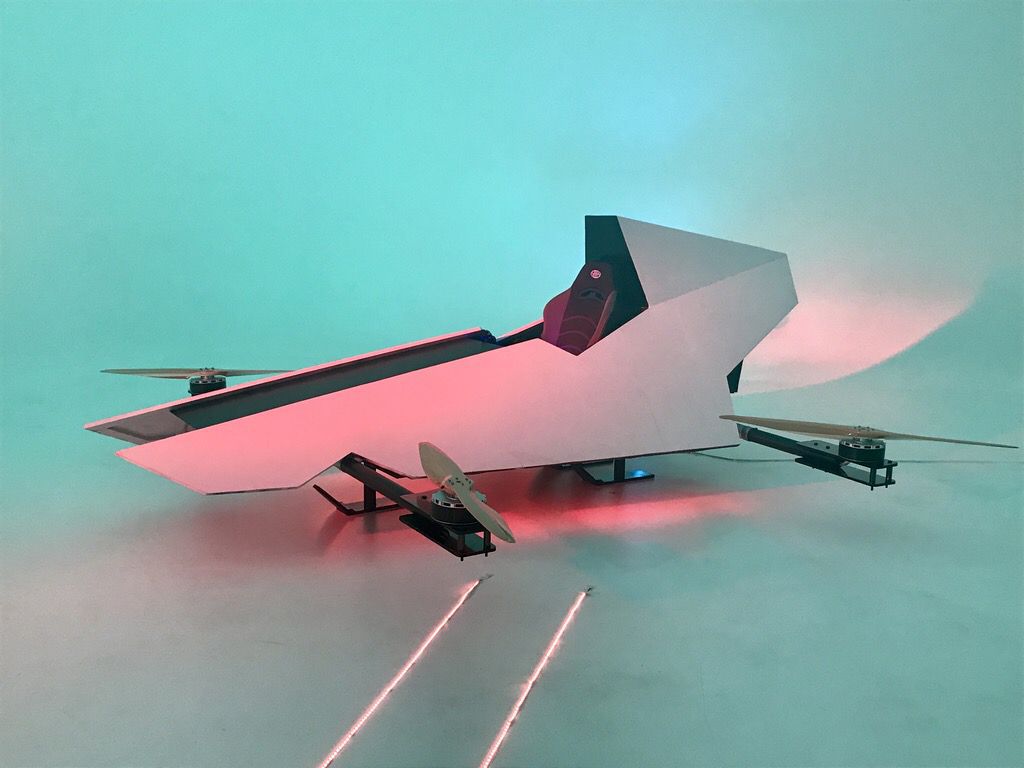An Overview of 3D Pens: History,Functioning,Brands and Features
An Overview of the History of 3D Pens
 3D drawing pens are a relatively new tool for makers, designers, artists, and hobbyists. The number of companies producing 3D pens has absolutely skyrocketed in the nearly three years since they were first introduced. This article provides an overview of 3D Pens and innovative features found on best rated 3D pens today.
3D drawing pens are a relatively new tool for makers, designers, artists, and hobbyists. The number of companies producing 3D pens has absolutely skyrocketed in the nearly three years since they were first introduced. This article provides an overview of 3D Pens and innovative features found on best rated 3D pens today.
Modern 3D drawing pens have been brought to a reality with the 2013 introduction of the WobbleWorks 3Doodler drawing pen. However, the idea of a hand-held 3D drawing pen has been around for while before then. The 1995 Stratasys patent, “Apparatus and method for creating three-dimensional objects,” made reference to the concept that both glue guns and wax-modeling guns can be used for creating 3D objects by dispensing heated fluids that solidify after being dispensed. The patent notes that these tools can be used for drawing in three dimensions but that the mechanical control in a 3D printer would be able to make vastly superior shapes than by hand.
How 3D Pens Work
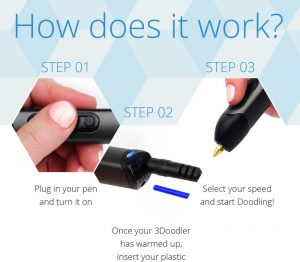 A 3D pen is like a handheld 3D printer. It consists of a heating element and an extruder like desktop 3D printers. Unlike desktop 3D printers where the nozzle movement is controlled by motors and computer software, the movement of 3D pen is controlled by our hands.
A 3D pen is like a handheld 3D printer. It consists of a heating element and an extruder like desktop 3D printers. Unlike desktop 3D printers where the nozzle movement is controlled by motors and computer software, the movement of 3D pen is controlled by our hands.
The plastic is heated at and pushed out of the tip of the nozzle of the pen. Once the plastic comes out, it is in molten form and can be given any shape. After a few seconds, it cools down and attains the shape it is worked into.
Innovative Features of 3D Pens
 An overview of 3D Pens is incomplete without mentioning the innovative features. In addition to these standard design features, innovative features that are of particular importance for 3D printing pen to be successful are listed below.
An overview of 3D Pens is incomplete without mentioning the innovative features. In addition to these standard design features, innovative features that are of particular importance for 3D printing pen to be successful are listed below.
Reliability and Ease of Cleaning
Although it may not seem particularly innovative, the best rated pens must have a high degree of reliability and ease of clearing any filament jam. Printing with a 3D pen by hand introduces a huge amount of variability and lends to jams. 3D Pen designs that are well thought out are heavily tested and will provide reliable use and save hours of time during the pen’s lifetime from being able to clean filament jams quickly.
Speed
The speed of extrusion is a feature that greatly enhances the user experience of a 3D printing pen. The speed of the extrusion depends on the components of the pen, with higher quality pens being able to extrude at rates far higher than others. A 3D printing pen with fast extrusion rates saves users time and provide an enhanced 3D printing experience.
Ergonomics
The ergonomics of 3D drawing pen is a feature that many 3D drawing pen companies attempt to capitalize on. Most designs today have a relatively similar shape with a large, cylindrical shaped body that is contoured to fit the thumb and forefinger of a hand. However, one company, LIX, produces a compact 3D pen that is the smallest currently available. Large or small, the choice between ergonomics or size is in the hand of the holder.
Filament type
One innovation in 3D printing pens that takes them to a whole new level is using a UV light curing polymer as an extrusion material (Polyes, Creopop). These pens use a liquid cartridge that is extruded at room temperatures and hardened with UV LEDs that are placed at the extrusion end of the 3D pen. These pens provide a benefit in that there is no heat required, so no chance of burns and no warm up time. UV-light curing pens are available with multiple colors, much like plastics, and can even be used to draw on bare skin. Additionally, the UV light can cure the extruded materials at a much higher rate than thermoplastics, since they are hardened almost instantly. However, a downside of these pens is that they require proprietary, UV-curing resins, which tends to be more expensive than standard ABS or PLA filament.
What Are The Best 3D Pen Brands
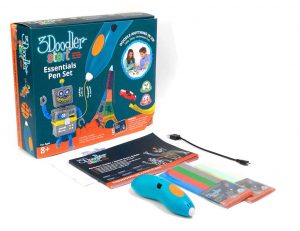 An overview of 3D Pens is not complete without mentioning about the brands. Since the first introduction of the WobbleWorks 3Doodler, the quantity of 3D printing pen companies has exploded. A few of these company are: CCbetter, Dim3W, Genesis, iEgrow, Joyluxy, Lay3r, LIX, Samto, Scribbler, Sunlu, YAYA, and 7Tech. All these companies provide mostly standard features but try to tweak some of the downsides of other products in an attempt to capture the market of 3D pen enthusiasts. Most innovations on 3D pens focus mainly on usability and experience, but there are some companies that are attempting to provide new experiences that bring 3D printing pens to a whole new level. Some of the standard features on nearly all 3D drawing pens are:
An overview of 3D Pens is not complete without mentioning about the brands. Since the first introduction of the WobbleWorks 3Doodler, the quantity of 3D printing pen companies has exploded. A few of these company are: CCbetter, Dim3W, Genesis, iEgrow, Joyluxy, Lay3r, LIX, Samto, Scribbler, Sunlu, YAYA, and 7Tech. All these companies provide mostly standard features but try to tweak some of the downsides of other products in an attempt to capture the market of 3D pen enthusiasts. Most innovations on 3D pens focus mainly on usability and experience, but there are some companies that are attempting to provide new experiences that bring 3D printing pens to a whole new level. Some of the standard features on nearly all 3D drawing pens are:
- Temperature indication
- Adjustable temperature (for selecting between PLA and ABS)
- Extrusion speed control
- Filament change buttons.
Conclusion
In summary, the 3D printing pen market has gone from one company to dozens in the last three years. 3Doodler lead the way, and realizing the market for 3D pens, other companies soon joined in. Reliability, Speed, and Ergonomics are three of the major innovations that successful 3D printing pens need to have today. Specialty resins, such as UV light curing, may provide for faster and safer 3D drawing pens, but proprietary liquids may limit their use. So with this, we conclude an overview of 3D Pens.
Get The Latest Tech News Updates Follow us on Facebook, Twitter, Google+, & Linkedin
